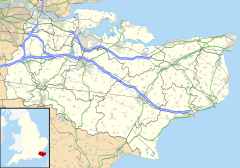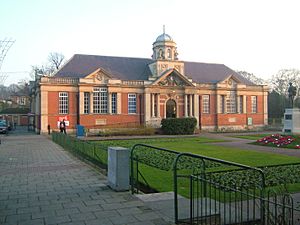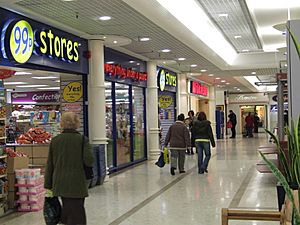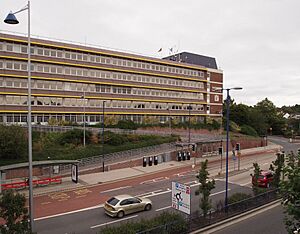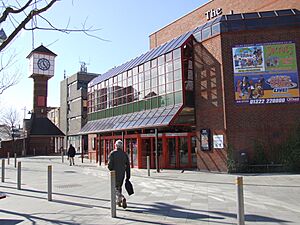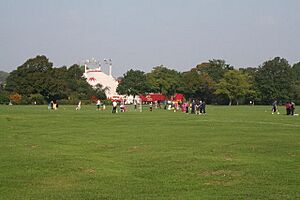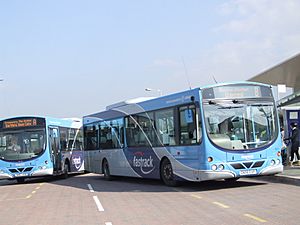Dartford facts for kids
Quick facts for kids Dartford |
|
|---|---|
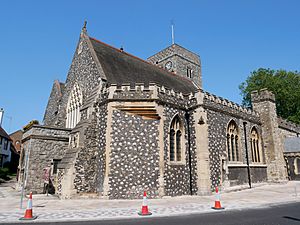 Holy Trinity Church, Dartford |
|
| Population | 51,240 |
| OS grid reference | TQ538739 |
| • London | 18.8 mi (30.3 km) |
| District |
|
| Shire county | |
| Region | |
| Country | England |
| Sovereign state | United Kingdom |
| Post town | DARTFORD |
| Postcode district | DA1, DA2 |
| Dialling code | 01322 |
| Police | Kent |
| Fire | Kent |
| Ambulance | South East Coast |
| EU Parliament | South East England |
| UK Parliament |
|
Dartford is a main town in Kent, England. It is about 18 miles (29 kilometres) south-east of Central London. The town is next to the London Borough of Bexley and across the Thames estuary from Thurrock in Essex. You can reach Essex by using the Dartford Crossing. Dartford has a population of 51,240 people.
The town centre is in a valley where the River Darent flows. An old road from London to Dover used to cross the river here. This is how Dartford got its name: Darent + ford. Dartford became a market town a long time ago. Today, many people who live here travel to Greater London for work. But Dartford still has a long and interesting history. It has been important for religion, industry, and culture. It is also a key place for trains. The main road now goes around the town, not through it.
Contents
Exploring Dartford's Location
Dartford is located in an area called the London Basin. To the north, there are low-lying marshlands. These areas are made of London Clay and mud brought by the River Darent and the River Cray. These two rivers meet in this area. The higher land where Dartford stands is made of chalk. It also has layers of sand and gravel.
Dartford grew because it was a good place to cross the river. It was also a meeting point for two important roads. One road went from west to east, connecting London with Europe. The other road followed the Darent valley to the south. Because of this, the main roads in Dartford look like the letter 'T'. The town has mostly grown to the south and east. This is because of the marshes to the north and the nearby town of Crayford to the west.
Within Dartford, there are different areas. These include the town centre, Joyce Green, and the Temple Hill estate. There are also two important open spaces. These are Central Park by the river and Dartford Heath. Several industrial areas are also part of the town.
 |
Erith, Slade Green | Purfleet | West Thurrock |  |
| Bexleyheath, Crayford | Stone, Bluewater Greenhithe |
|||
| Joydens Wood and Dartford Heath | Wilmington Hextable Swanley |
Darenth, Sutton at Hone, Horton Kirby |
Dartford's Weather
Dartford has an oceanic climate, just like most of the United Kingdom. This means it has mild winters and cool summers. It also gets rain throughout the year.
Dartford Heath: A Natural Space
Dartford Heath is a large open space south-west of Dartford. It covers about 314 acres (127 ha). This area has always been important. Very old burial mounds and Bronze Age tools have been found here. The first local cricket game was played here in 1723. The Heath is a beautiful natural area. It has three ponds and different types of habitats. These include grassy areas, woodlands, and areas with heather and gorse plants. It is a common land, which means it has stayed open for everyone to use. People use Dartford Heath for recreation, like cycling and dog walking.
The Dartford warbler bird was not named after Dartford Heath. It was first seen and described on Bexley Heath, which is near Dartford.
A Look at Dartford's History
People first lived in the Dartford area around 250,000 years ago. These were ancient hunter-gatherers. Many discoveries show that people lived here during the Stone Age, Bronze Age, and Iron Age.
When the Romans built their road from Dover to London, they needed to cross the River Darent. This crossing point was a "ford," which gave Dartford its name. Roman country houses were built along the Darent Valley. The Saxons might have started the first settlement where Dartford is now. Dartford is even mentioned in the Domesday Book from 1086. At that time, the king owned it.
During the Middle Ages, Dartford was a key stop for pilgrims and travellers. They were on their way to Canterbury and Europe. Different religious groups settled in the area. In the 12th century, the Knights Templar owned land in Dartford. A part of their history can still be seen at Sutton-at-Hone. In the 14th century, a priory was built here. Two groups of friars, the Dominicans and the Franciscans, also built hospitals. At this time, Dartford became a small but important market town.
Wat Tyler, a leader of the Peasants' Revolt, might have been from Dartford. Some say he was a local hero, but other towns also claim him. Dartford was likely a meeting point for rebels during the Peasants' Revolt in 1381. Rebels from Essex joined those from Kent in Dartford. They were upset about how a man named Robert Belling was treated. The rebels then marched to London.
In the 15th century, two English kings were part of Dartford's story. Henry V marched through Dartford in 1415 with his soldiers. He was on his way to the Battle of Agincourt. In 1422, Henry's body was brought to Holy Trinity Church for a funeral. In 1452, Richard, Duke of York, set up camp in Dartford. He had many men and was waiting to meet King Henry VI. The Duke later gave up to the king in Dartford. Today, York Road marks the place where the camp was.
The 16th century brought big changes to Dartford. New industries started to grow. The priory was destroyed in 1538. Later, King Henry VIII built a new manor house. Many Protestants were executed during the reigns of Queen Mary and Philip and Mary. This included Christopher Wade, who was burned at the stake in Dartford in 1555. A memorial on East Hill remembers him and other martyrs. In 1576, Dartford Grammar School was founded. This showed the importance of education during the Tudor period.
Dartford's Industrial Past
Dartford's first industries were linked to farming. These included making traditional beers and ales. People also burned lime and mined chalk. Fulling, which cleans wool, also needed a lot of water from the river. This led to other industries that used water power for machines.
In 1588, Sir John Spilman started England's first paper mill in Dartford. It employed about 600 people, which was very important for the town. In 1595, England's first iron-slitting mill was set up in Dartford. It was built by Godfrey Box, who came from the Low Countries. In 1785, a blacksmith started making engines and machinery. Some of this was for a local gunpowder factory. Also in 1785, the company J & E Hall started. They focused on heavy engineering and later made cooling equipment. By 1906, they were even making vehicles.
These early businesses helped Dartford grow and become rich. In 1840, the Saunders & Harrison mustard factory was one of the biggest in the country. Dartford Paper Mills were built in 1862. Between 1844 and 1939, a fabric printing works used the river's water. RAF Joyce Green, near Dartford, was one of the first airfields for the Royal Flying Corp. It was started by Vickers Limited in 1911. During World War I, the Vickers factory made many more products. This helped the local economy. The Burroughs-Wellcome chemical works (now part of GlaxoSmithKline) made Dartford a centre for the pharmaceutical industry. Many Belgian refugees came to Dartford during the war. Since 1939, there has been a large power station at Littlebrook on the Thames.
Modern Economy and Future Plans
Some of Dartford's main industries, like brewing and paper-making, have declined. This caused job losses. The Swanscombe Cement Works, which is now the Bluewater shopping centre, closed in 1990. This industry had been good for the area but left behind damaged land and pollution. In 1990, Dartford had about 1,700 acres (6.9 km2) of spoiled land from mining. Cement dust pollution was also a common complaint.
The closing of major employers and the growth of nearby shopping areas affected Dartford's economy. However, the town is still home to big stores like Sainsbury's, W.H. Smiths, and Boots. With the opening of the large Bluewater shopping centre nearby, Dartford's high street has seen more budget-friendly stores. In the 1990s, new business parks helped the local economy. The biggest is Crossways Business Park. The old offices of Hall-Thermotank are now the Dartford Civic Centre.
In 2007, more chain stores opened in Dartford. These included B&Q, M&S Simply Food, TK Maxx, and Asda Living. The Orchards, another shopping centre, also opened. The main High Street and The Priory shopping centre have faced challenges. The oldest independent business, Richardson & Sons butchers, closed in 2014. This was to make way for a new superstore development, but those plans were later cancelled.
The Mazda car company has its UK head office at the Crossways Business Park. Thomas Walter Jennings created the famous Vox music brand in Dartford. Its first products, like the AC15 and AC30 amplifiers, were made here. The former GlaxoSmithKline factory site is planned to be redeveloped. There are plans to build over 1,000 homes, offices, shops, and restaurants.
Culture and Community Life
The Orchard Theatre is a professional theatre in the town centre. It hosts plays, dance shows, music, and other entertainment. The Mick Jagger Centre, located at Dartford Grammar School, opened in 2000. It provides facilities for community arts. The library and Museum are on Market Street.
Central Park, in the town centre, is a 26 acres (110,000 m2) open space. It is used for many community events.
Sports in Dartford
Dartford F.C. is a football club that plays at Princes Park Stadium. They compete in the National League South. There are other football clubs in Dartford too, like Fleetdown United and Halls AFC.
Dartford Harriers Athletic Club started in 1922. It is based at Central Park. The club began as a rugby team, but running became more popular. Their blue and blue "hoops" colours come from their old rugby shirts.
Dartfordians Rugby Football Club has five adult teams and a large youth section. They play their home games at War Memorial Club House.
Dartford is also home to the Dartford and White Oak Triathlon Club. It was formed in 1988 and is one of the oldest triathlon clubs in the UK. They train at The Bridge Estate.
Sports centres in Dartford include the Becket Sports Centre. It is located at Dartford Grammar School.
Media and News
Because Dartford is close to London, it receives television signals from the Crystal Palace TV transmitter. This means Dartford is in the BBC London and ITV London areas. Some parts of the town can also get signals from the Bluebell Hill TV transmitter. This broadcasts BBC South East and ITV Meridian.
Local radio stations include BBC Radio Kent (96.7 FM), Heart South (103.1 FM), and KMFM West Kent (96.2 FM).
The town has two local newspapers: the Dartford & Swanley News Shopper and the Dartford Messenger.
Getting Around Dartford
Roads and Crossings
An ancient Celtic road, later paved by the Romans, passed near Dartford. This road was called Watling Street. Over time, traffic started going through the town itself. By the 18th century, there was so much traffic that roads needed better care. Turnpike Trusts were set up to manage roads. Dartford had two of these toll roads.
From 1925, the A2 main road helped traffic avoid Dartford town centre. Today, the original main road through town is the A226. The old road south to Sevenoaks is now the A225. A newer road, the A206, goes around the north of the town. It helps traffic from riverside industrial areas get to the Dartford Crossing.
Dartford is perhaps best known for the Dartford Crossing. This is the main way to cross the River Thames east of London. The southbound A282 (part of the London Orbital) crosses the river using the Queen Elizabeth II Bridge. This bridge opened in 1991. The northbound traffic uses the twin Dartford Tunnels. The first tunnel opened in 1963, and the second in 1980.
Train Travel
Dartford railway station is in the town centre. It connects to London through three National Rail routes. The first train line to London opened in 1849. Later, two more lines were built: the Dartford Loop Line in 1866 and the Bexleyheath Line in 1895. All these lines were made electric by 1926.
Two train companies serve Dartford station:
- Southeastern provides services to places like Gravesend, London Charing Cross, London Cannon Street, and London Victoria.
- Thameslink operates a route between Rainham (Kent) and Luton.
Bus Services
Dartford has many bus services. These are provided by Transport for London, Arriva Kent Thameside, and Go Coach Buses.
These buses connect Dartford to nearby areas. These include Bluewater, Bexleyheath, Crayford, Erith, Gravesend, Greenhithe, Orpington, Sidcup, Swanley, Welling, and Woolwich.
Education in Dartford
Dartford has many schools for different age groups. These include primary schools, secondary schools, and grammar schools. For a full list, you can check the List of schools in Kent#Dartford.
Places of Worship
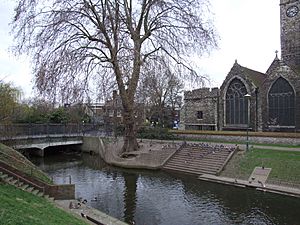
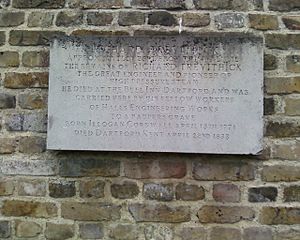
The main church in Dartford is Holy Trinity. It is on the west side of the River Darent. Long ago, a hermit would help travellers cross the river here. The church was first built by Saxons in the 9th century. Later, Normans added to it. A royal wedding was held there in the 13th century. Inside the church, there is a plaque for Richard Trevithick. He was a pioneer of steam power who lived and died in Dartford.
Other places of worship in Dartford include Brent Methodist Church, Dartford Methodist Church, and St Alban's Church.
The church graveyard is in St Edmund's Pleasance, on East Hill. This led to an old rhyme about Dartford: "Dirty Dartford, filthy people, bury their dead above the steeple." The church actually has a tower, not a steeple.
Twin Towns
Dartford is twinned with two towns:
- Hanau in Hesse, Germany
- Gravelines, France
Famous People from Dartford
Many interesting people have lived in or are from Dartford:
- Andrea Arnold (born 1961), a film director who has won Oscars and BAFTAs.
- Bernie Ecclestone (Born 1930), the former CEO of Formula 1. He grew up in Dartford.
- Len Goodman (1944-2023), a famous dance expert.
- Mick Jagger (born 1943), the singer and songwriter for The Rolling Stones.
- Keith Richards (born 1943), the guitarist and songwriter for The Rolling Stones.
- Pete Tong (born 1960), a well-known house DJ.
- Richard Trevithick (1771–1833), an inventor and engineer who died in Dartford.
- Margaret Thatcher (1925–2013), who later became Prime Minister, ran to be a Member of Parliament for Dartford in 1950 and 1951.
Images for kids
See also
 In Spanish: Dartford para niños
In Spanish: Dartford para niños


